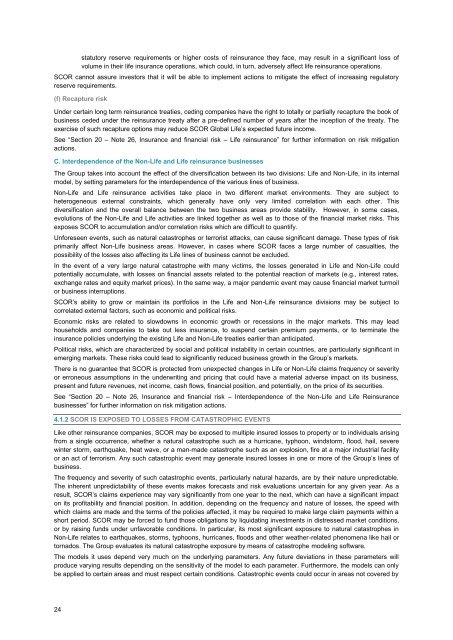4.4 Legal risk - Scor
4.4 Legal risk - Scor
4.4 Legal risk - Scor
You also want an ePaper? Increase the reach of your titles
YUMPU automatically turns print PDFs into web optimized ePapers that Google loves.
statutory reserve requirements or higher costs of reinsurance they face, may result in a significant loss of<br />
volume in their life insurance operations, which could, in turn, adversely affect life reinsurance operations.<br />
SCOR cannot assure investors that it will be able to implement actions to mitigate the effect of increasing regulatory<br />
reserve requirements.<br />
(f) Recapture <strong>risk</strong><br />
Under certain long term reinsurance treaties, ceding companies have the right to totally or partially recapture the book of<br />
business ceded under the reinsurance treaty after a pre-defined number of years after the inception of the treaty. The<br />
exercise of such recapture options may reduce SCOR Global Life’s expected future income.<br />
See “Section 20 – Note 26, Insurance and financial <strong>risk</strong> – Life reinsurance” for further information on <strong>risk</strong> mitigation<br />
actions.<br />
C. Interdependence of the Non-Life and Life reinsurance businesses<br />
The Group takes into account the effect of the diversification between its two divisions: Life and Non-Life, in its internal<br />
model, by setting parameters for the interdependence of the various lines of business.<br />
Non-Life and Life reinsurance activities take place in two different market environments. They are subject to<br />
heterogeneous external constraints, which generally have only very limited correlation with each other. This<br />
diversification and the overall balance between the two business areas provide stability. However, in some cases,<br />
evolutions of the Non-Life and Life activities are linked together as well as to those of the financial market <strong>risk</strong>s. This<br />
exposes SCOR to accumulation and/or correlation <strong>risk</strong>s which are difficult to quantify.<br />
Unforeseen events, such as natural catastrophes or terrorist attacks, can cause significant damage. These types of <strong>risk</strong><br />
primarily affect Non-Life business areas. However, in cases where SCOR faces a large number of casualties, the<br />
possibility of the losses also affecting its Life lines of business cannot be excluded.<br />
In the event of a very large natural catastrophe with many victims, the losses generated in Life and Non-Life could<br />
potentially accumulate, with losses on financial assets related to the potential reaction of markets (e.g., interest rates,<br />
exchange rates and equity market prices). In the same way, a major pandemic event may cause financial market turmoil<br />
or business interruptions.<br />
SCOR’s ability to grow or maintain its portfolios in the Life and Non-Life reinsurance divisions may be subject to<br />
correlated external factors, such as economic and political <strong>risk</strong>s.<br />
Economic <strong>risk</strong>s are related to slowdowns in economic growth or recessions in the major markets. This may lead<br />
households and companies to take out less insurance, to suspend certain premium payments, or to terminate the<br />
insurance policies underlying the existing Life and Non-Life treaties earlier than anticipated.<br />
Political <strong>risk</strong>s, which are characterized by social and political instability in certain countries, are particularly significant in<br />
emerging markets. These <strong>risk</strong>s could lead to significantly reduced business growth in the Group’s markets.<br />
There is no guarantee that SCOR is protected from unexpected changes in Life or Non-Life claims frequency or severity<br />
or erroneous assumptions in the underwriting and pricing that could have a material adverse impact on its business,<br />
present and future revenues, net income, cash flows, financial position, and potentially, on the price of its securities.<br />
See “Section 20 – Note 26, Insurance and financial <strong>risk</strong> – Interdependence of the Non-Life and Life Reinsurance<br />
businesses” for further information on <strong>risk</strong> mitigation actions.<br />
4.1.2 SCOR IS EXPOSED TO LOSSES FROM CATASTROPHIC EVENTS<br />
Like other reinsurance companies, SCOR may be exposed to multiple insured losses to property or to individuals arising<br />
from a single occurrence, whether a natural catastrophe such as a hurricane, typhoon, windstorm, flood, hail, severe<br />
winter storm, earthquake, heat wave, or a man-made catastrophe such as an explosion, fire at a major industrial facility<br />
or an act of terrorism. Any such catastrophic event may generate insured losses in one or more of the Group’s lines of<br />
business.<br />
The frequency and severity of such catastrophic events, particularly natural hazards, are by their nature unpredictable.<br />
The inherent unpredictability of these events makes forecasts and <strong>risk</strong> evaluations uncertain for any given year. As a<br />
result, SCOR’s claims experience may vary significantly from one year to the next, which can have a significant impact<br />
on its profitability and financial position. In addition, depending on the frequency and nature of losses, the speed with<br />
which claims are made and the terms of the policies affected, it may be required to make large claim payments within a<br />
short period. SCOR may be forced to fund those obligations by liquidating investments in distressed market conditions,<br />
or by raising funds under unfavorable conditions. In particular, its most significant exposure to natural catastrophes in<br />
Non-Life relates to earthquakes, storms, typhoons, hurricanes, floods and other weather-related phenomena like hail or<br />
tornados. The Group evaluates its natural catastrophe exposure by means of catastrophe modeling software.<br />
The models it uses depend very much on the underlying parameters. Any future deviations in these parameters will<br />
produce varying results depending on the sensitivity of the model to each parameter. Furthermore, the models can only<br />
be applied to certain areas and must respect certain conditions. Catastrophic events could occur in areas not covered by<br />
24
















